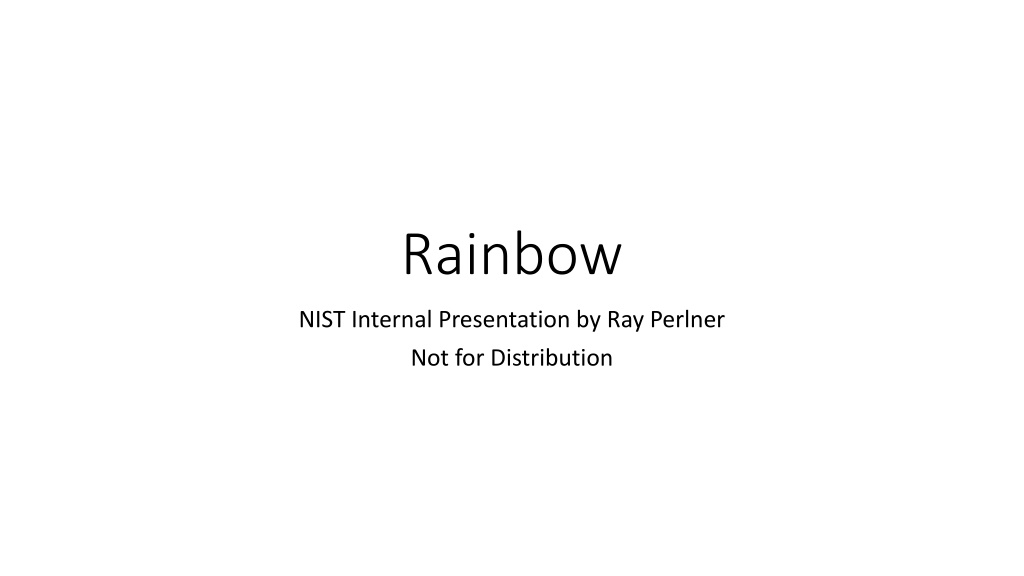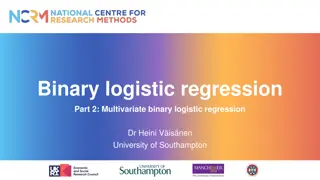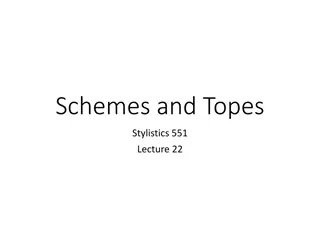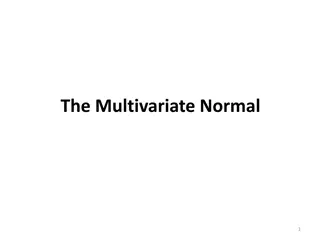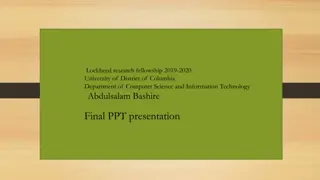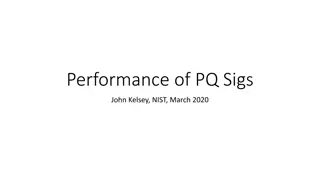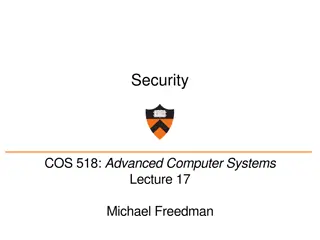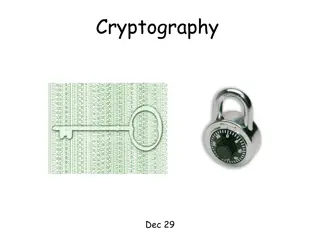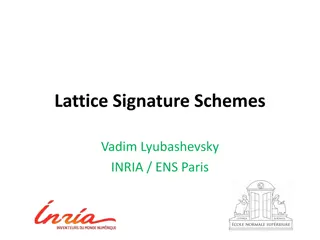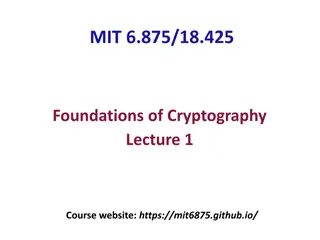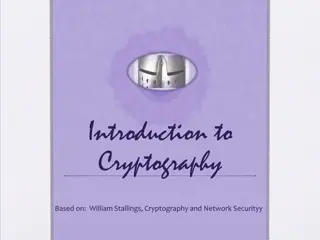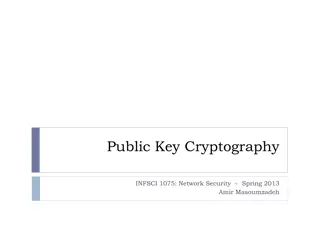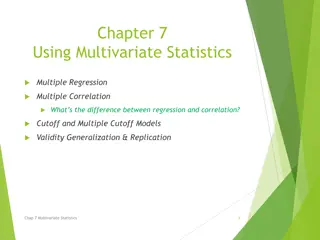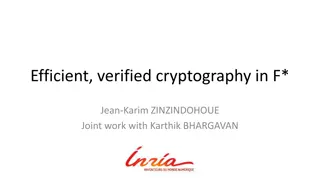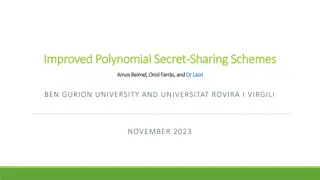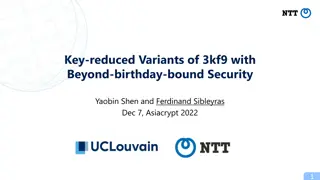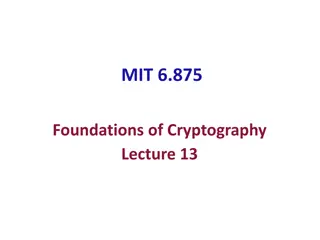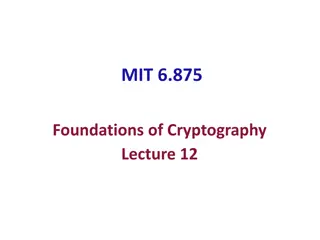Understanding Multivariate Cryptography Schemes
Multivariate cryptography involves systems of polynomial equations, with public keys based on polynomial functions. GeMSS and Rainbow are discussed, highlighting their design features and vulnerabilities. The Butterfly Construction method in multivariate schemes constructs public keys using easily invertible quadratic functions, ensuring uniqueness in encryption and signatures.
Download Presentation

Please find below an Image/Link to download the presentation.
The content on the website is provided AS IS for your information and personal use only. It may not be sold, licensed, or shared on other websites without obtaining consent from the author. Download presentation by click this link. If you encounter any issues during the download, it is possible that the publisher has removed the file from their server.
E N D
Presentation Transcript
Rainbow NIST Internal Presentation by Ray Perlner Not for Distribution
A Brief Summary GeMSS (Alternate) is extremely broken Major Design Features (the v and (-) modifiers of HFEv- do not provide security) To compensate modifications making GeMMS orders of magnitude slower would be required Almost certainly should be removed from consideration Rainbow (Finalist) is slightly broken A new MinRank attack by Buellens (combined with recent improvements in algorithms for MinRank) breaks the recently tweaked 3rdround parameters for Rainbow With an additional fairly small adjustment, parameters would meet security targets Nonetheless, it s worrying that a novel and relatively simple attack was found this late in the process
GeMSS and Rainbow Commonalities Both Multivariate Signature Schemes Large public key/ Small signature Differences GeMSS is a big-field scheme based on HFEv- Rainbow is a small-field scheme based on UOV Attacks GeMSS is very broken Rainbow is a little broken
Multivariate Cryptography Public key is a system of ? polynomial equations in ? variables over ?(?) E.g.: ?1= 2?1 3+ ?1 2+ 3?1+ ?2+ 1 2?2+ ?2 2+ ?1?2+ 4?1 2?2+ 3?1?2 ?2= 2?1 For encryption: plaintext is given by ??and ciphertext is given by ?? For signatures: signature is given by ??and message digest is given by ?? Solving multivariate systems of equations is NP hard in general for polynomials of degree 2 or higher (degree 2 is most used) Private key is some special structure that allows the private-key holder to solve for ??
Multivariate Cryptography 2 Butterfly Construction In most multivariate schemes the public key is constructed as: ????(?) = ? ? ?(?) ? is an easily invertible quadratic function from ? input variables to ? output variables For signatures typically ? < ? so that everything in the range of ? has an inverse For encryption typically ? > ? so that two plaintexts are unlikely to produce the same ciphertext ? and ? are affine maps (usually invertible) E.g.: ?1= ?1+ 3?2+ 4 ?2= 3?1+ 2?2+ 1
Unbalanced Oil and Vinegar A Multivariate Scheme Not Vulnerable to MinRank To construct an easily invertible ? Split the ? = ? + ? input variables into ? oil variables and ? vinegar variables Typically, ? is at least twice as much as ? (unbalanced) ? gives ? = ? equations in these variables Set some of the quadratic coefficients to 0 Terms that multiply a vinegar variable by a vinegar variable may be nonzero Terms that multiply a vinegar variable by an oil variable may be nonzero Terms that multiply an oil variable by an oil variable MUST be zero. To invert ?: Pick random values for the vinegar variables and plug them in Now we have ? linear equations in the ? oil variables
Matrix Representation of ??Using the Discrete Differential ????,? = ??? + ? ??? ??? + ??? Its entries are the (symmetrized) coefficients of quadratic monomials in ? ??? = ??????? ? ? (???)??????; ????,? = ?,? ??? ??? ???? ? < ? ? < ? ? = ? (???)??= ???is a 2-tensor: i.e. for linear map/change-of-basis ?: ? = ???? ?? ?,?= ?????,?? ??? Alternatively, ???can be thought of a matrix where ??? = ??????
Matrix Representation of ? We can use this matrix (2-tensor) representation of ? to plot the zero and nonzero coefficients of each of the ? equations in the UOV central map (zero oil/oil coefficients on the bottom right): Nonzero coefficients marked in blue
Why Unbalanced? Attack on Balanced OV: Public key differentials of each equation have the form: ?? ?? 0 The first proposed Oil and Vinegar scheme by Patarin was balanced, i.e.? = ? ? ? ? Kipnis and Shamir broke the scheme in 1998 Kipnis, Patarin, and Goubin proposed unbalanced oil and vinegar to defeat the attack in 1999. UOV still appears to be secure 0 ? ? ?? 1 And their inverses have the form: ? 1 ?? Multiply one equation s differential by another equation s inverse differential: Now has the form: ? 1 ? 0 ? ? ? The vinegar variables can be separated, because they form an invariant subspace. Private key recovery!
Rainbow Ding proposed the Rainbow variant of UOV Three classes of variables: Vinegar 1 variables, Vinegar 2 variables, Oil Variables Two layers of equations in ? First layer is like OV Vinegar 1 picked randomly (act as vinegar variables) Vinegar 2 solved for (act as oil variables) Oil are absent Second layer is like UOV Vinegar 1 and 2 are plugged in with values from first layer (act as vinegar variables) Oil are solved for (act as oil variables)
Attacks on Rainbow The Rainbow submission analyzed 5 attacks: Direct attack, MinRank attack, HighRank attack, UOV attack, Rainbow Band Separation (RBS) attack Developments in Round 2 The complexity of the MinRank attack was dramatically reduced by the Support Minors technique for solving the generic MinRank problem This did not break any Rainbow parameter set, though The complexity of the RBS attack was reduced slightly by (Perlner, Smith-Tone 2020) Previous experimental evidence from (Thomae 2012) suggested that RBS attack is cheaper than existing analysis indicated for small parameters Perlner, Smith-Tone explained these experiments and generalized to all parameters Since RBS was the best attack for several parameter sets, this prompted a readjustment of parameters
Attacks on Rainbow Developments in Round 3 Beullens proposed a new way to use MinRank to attack Rainbow This reduced the security of the new (and old) parameter sets a modest amount Rather than adjust their parameters again, the Rainbow team argued they still met their security targets due to memory costs Ongoing analysis suggests that a proper accounting of memory costs likely increases the complexity of both the old and new attacks, but not enough for Rainbow s parameter sets to meet security targets
Support Minors Method for Solving MinRank MinRank definition: Given ? matrices of dimension ? ? over a (finite) field ??, find a linear combination with rank ?
Rank Decomposition Modeling [Bardet, Bros, Cabarcas, Gaborit, Perlner, Smith-Tone, Tillich, Verbel 2020] Since our target matrix is rank ?, it can be decomposed as the product of an ? ? matrix ? and an ? ? matrix ? This can generically be applied to MinRank: ?? = ???? 16
Support Minors Modeling [Bardet, Bros, Cabarcas, Gaborit, Perlner, Smith-Tone, Tillich, Verbel 2020] Consider a row of ???? = ?? ???? It is linearly dependent on the rows of ? i.e.: ?? ???? ???? ?1 ?? = ?1 ?? has rank at most ? So its (? + 1) (? + 1) minors are zero Note these minors can be expanded as linear polynomials in ?? times r ? minors of ? Multiply by degree ? 1 monomials in ?? Resulting equations are degree 1 in ? ? minors of ? and degree ? in ?? 17
Support Minors Modeling How Many: Monomials? Linearly Independent (LI) Equations? ? There are ? ? ? + ? 1 ? ? + ? ? 1 ? ? ?? ? minors of ? ( 1)? 1 ? + ? ?=1 There are? + ? 1 in ?? degree-? monomials ? Note: this formula only works when ? < ? + 2 Read the paper to see why Formula extensively tested with experiments can it be proven? When we have more LI equations than monomials, we can solve! ? ? So ? + ? 1 ? If we have more LI equations than this, we can solve 18
Old MinRank Attack on Rainbow Public key differentials are linear combinations of layer 2 maps: ? ?? ?? ? ? ?? ? ? 0 ?? ? And layer 1 maps: ? ?? 0 ? 0 0 0 0 0 ?? ? Layer 1 maps are not full rank So they can be found by solving MinRank on the public differentials
Effect of Support Minors on MinRank Complexity of Old MinRank Attack
RBS is Better than We Thought (Perlner, Smith Tone 2020) RBS is an algebraic (equation solving) key recovery attack proposed in (Ding et. al 2008) (Thomae 2012) included experimental data indicating the RBS equations are easier to solve with Grobner Basis Software than generic systems Perlner, Smith-Tone explain this by noting that there are two different variable types which can be treated differently in order to solve the system with a lower complexity Net effect:
Round 3 Developments The Rainbow team tweaked their parameters to respond to the RBS attack improvement Beullens proposed a new way to use MinRank to attack Rainbow this reduced the security of the new (and old) parameter sets a modest amount Rather than adjust their parameters again, the Rainbow team argued they still met their security targets due to memory costs Ongoing analysis suggests that a proper accounting of memory costs likely increases the complexity of both the old and new attacks, but not enough to meet security targets
Reminder: Old MinRank attack on Rainbow Public key differentials are linear combinations of layer 2 maps: ? ?? ?? ? ? ?? ? ? 0 ?? ? And layer 1 maps: ? ?? 0 ? 0 0 0 0 0 ?? ? Layer 1 maps are not full rank So they can be found by solving MinRank on the public differentials
Ward Beullens Rectangular MinRank Attack (https://eprint.iacr.org/2020/1343) There s another way to attack Rainbow with MinRank Consider matrices whose ?th row is ???? for some row-vector ? These form an ?-dimensional space of ? ? matrices In particular, let ? have the form (??) 10 Then rows are linear combinations of (From Layer 2 differentials): 0 ?0 ? ?? ?? ? ? ?? ? ? 0 ??? ? = ?0?? ?0?? 0 ? And (From Layer 1 differentials): ? ?? 0 ? 0 0 0 0 0 ??? ? = 0 So this matrix ain t full rank neither. Can also be found via MinRank!
But Memory! (https://troll.iis.sinica.edu.tw/by-publ/recent/response-ward.pdf) Rather than tweak parameters again, the Rainbow team posted a note claiming they still meet the NIST security targets if you account for memory costs. Their estimates were:
But Memory! Questionable assumptions Rainbow s response follows DJB s favored RAM cost estimate: Accessing a bit in a RAM of size M is reckoned as ?1/2/25 bit operations Assumes memory is arranged strictly in 2 dimensions Constants are estimated based on DRAM density and energy costs for moving information in an integrated circuit Probably should assume: Some use of 3rd dimension Lower fiber optic communication costs (when memories are in petabyte range or bigger) Flash/HDD densities (when latency doesn t matter, or for exascale+ memories)
But Memory! Is it Really Random Access? Can we use structure of the problem to make memory access more local? Analyzed in the same in-progress paper where we (Baena, Briaud, Cabarcas, Perlner, Smith-Tone Verbel) improve the GeMSS attack. Through some combination of arranging memory so that data can be processed mostly locally caching memory that s used multiple times blocking data together to avoid sending addresses We reduce estimated cost (even following DJB s memory cost estimates) to:
Rainbow Summary Rainbow is a Finalist Signature scheme that offers: Huge public keys (even with compression) Small signatures Fast verification (with the uncompressed key) Rainbow is a little bit broken The flurry of attacks in the 2nd/3rd round may bring the maturity of Rainbow into question The current best attack looks structurally pretty different from what was believed to be the best attack in Round 1 Or the fact that the security moved only a little could be encouraging Seems like parameters that are strong against previously known attacks are also fairly good against the new ones
Options: Let s Discuss Standardize Rainbow Now! Would need to downgrade existing parameters claimed security and drop category I parameters Probably don t want to do this, but wouldn t be completely crazy Make Rainbow an Alternate Are we keeping any Alternate signatures for a 4th Round? Or is everything OnRamp after round 3? Pre-admit Rainbow to OnRamp Give Rainbow no official status (remove current submission from consideration) but suggest it be submitted to OnRamp OR actively discourage from submitting it to OnRamp
References Support Minors: https://hal.archives-ouvertes.fr/hal- 02475356v3/document RBS Better than we Thought: https://eprint.iacr.org/2020/702 Rectangular MinRank: https://eprint.iacr.org/2020/1343 Rainbow Response: https://troll.iis.sinica.edu.tw/by-publ/recent/response- ward.pdf Older References on RBS: RBS Original Paper: https://eprint.iacr.org/2008/108.pdf Thomae (includes RBS experiments): https://eprint.iacr.org/2012/223.pdf
